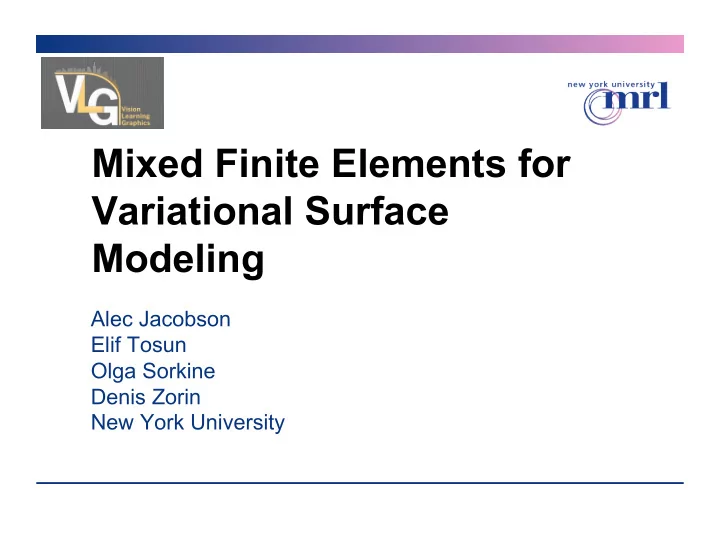

Mixed Finite Elements for Variational Surface Modeling Alec Jacobson Elif Tosun Olga Sorkine Denis Zorin New York University
Motivation Produce high-quality surfaces Via energy minimization Or solving Partial Differential Equations Laplacian energy Laplacian gradient energy Biharmonic equation Triharmonic equation
Motivation Obtain different boundary conditions Curve Region Point
Motivation Higher-order equations on mesh (i.e. piecewise linear elements) Dealing with higher-order derivatives not straightforward
Previous work Simple domains, analytic boundaries [Bloor and Wilson 1990] Model shaped minimization of curvature variation energy [Moreton and Séquin 1992] Interpolate curve networks, local quadratic fits and finite differences [Welch and Witkin 1994] Uniform-weight discrete Laplacian [Taubin 1995] Cotangent-weight discrete Laplacian [Pinkall and Polthier 1993], [Wardetzky et al. 2007], [Reuter et al. 2009] Wilmore flow, using FEM with aux variables Position and co-normal specification on boundary [Clarenz et al. 2004] Linear systems for k-harmonic equations Uses discretized Laplacian operator [Botsch and Kobbelt 04]
Previous work Simple domains, analytic boundaries [Bloor and Wilson 1990] Model shaped minimization of curvature variation energy [Moreton and Séquin 1992] Interpolate curve networks, local quadratic fits and finite differences [Welch and Witkin 1994] Uniform-weight discrete Laplacian [Taubin 1995] Cotangent-weight discrete Laplacian [Pinkall and Polthier 1993], [Wardetzky et al. 2007], [Reuter et al. 2009] Wilmore flow, using FEM with aux variables Position and co-normal specification on boundary [Clarenz et al. 2004] Linear systems for k-harmonic equations Uses discretized Laplacian operator [Botsch and Kobbelt 04]
Standard Finite Element Method Requires at least C 1 elements for fourth order Can’t use standard triangle meshes High order surfaces exist, (e.g. Argyris triangle) Require many extra degrees of freedom Not popular due to complexity Low order, C 0 , workarounds E.g. mixed elements
Discrete Geometric Discretization Derive mesh analog of geometric quantity E.g. Laplace-Beltrami operator integrated over vertex area Re-expressed using only first-order derivatives Use average value as energy of vertex area Used often in geometric modeling No obvious way to connect to continuous case
Mixed Elements Introduce additional variable to convert high order problem to low order
Mixed Elements Introduce additional variable to convert high order problem to low order Use Langrange multipliers to enforce constraint Constraint structure also makes certain boundary types easier
Mixed Elements Our original higher order problem Introduce an additional variable Two second order problems Can use just linear elements Curve Fixed boundary curve Specified tangents:
Mixed Elements Discretize with piecewise linear approximations for variables Discrete Laplacian Mass matrix
Mixed Elements Discretize with piecewise linear approximations for variables Discrete Laplacian Mass matrix
Mixed Elements Matrix form, curve boundary conditions Neumann matrix Discrete Laplacian Mass matrix Where and Diagonalized, lumped mass matrices eliminate auxiliary variable
Boundary Conditions Curve Fixed boundary curve Specified tangents: Point Single fixed points on surface
Boundary Conditions Region Fixed part of mesh outside solved region
Mixed Elements Use Lagrangian to enforce region condition Discretize with piecewise linear approximations for variables Discrete Laplacian Mass matrix May also eliminate aux. variable
Boundary Conditions Region: Curve: Difference in right-hand side Curve conditions don’t require lumped mass matrix But we use it in practice, for speed and numerical accuracy Equivalent to [Botsch and Kobbelt, 2004] Specified tangents ≈ parameter for continuity control
Boundary Conditions Region Fixed part of mesh outside solved region
Boundary Conditions Convert high order problem to low order problem Use Langrange multipliers to enforce constraint
Boundary Conditions Convert high order problem to low order problem Use Langrange multipliers to enforce constraint Notice similarity to Lagrangian for biharmonic
Mixed Elements Discretization, formulation works the same way where Discrete Laplacian Eliminate auxiliary variables Leaving system with only Mass matrix
Boundary Conditions Curve Fixed boundary curve Specified tangents and curvatures: , Leads to singular systems
Boundary Conditions Curve Region Fixed boundary curve and one ring into interior Specified curvatures:
Experimental Results Tested convergence of our systems Randomly generated domains of varying irregularity One vertex placed randomly in each square of grid Parameter controlled variation from regular Connected using Triangle Library Control minimal interior angles
Experimental Results Specify boundary conditions using analytic target functions: Try to reproduce original function by solving system: Measure error between analytic target and our mixed FEM approximation
Experimental Results Nearly optimal convergence for biharmonic
Experimental Results Boundary conditions perform differently for triharmonic
Applications Filling in holes: Laplacian energy input
Applications Filling in holes: Laplacian energy region input constraint
Applications Filling in holes: Laplacian energy region input manipulating tangent controls constraint
Applications Filling in holes: Laplacian energy manipulating tangent controls
Applications Filling in holes: Laplacian gradient energy manipulating curvature region input controls constraint
Applications Specifying tangents in Laplacian energy around regions
Applications
Applications Biharmonic Triharmonic
Summary Technique for discretizing energies or PDEs Reduce to low order by introducing variables Use constraints to enforce region boundary conditions Lump mass matrix Convergence for fourth- and sixth-order PDEs
Summary Technique for discretizing energies or PDEs Reduce to low order by introducing variables Use constraints to enforce region boundary conditions Lump mass matrix Convergence for fourth- and sixth-order PDEs Future work Improve convergence of triharmonic solution Explore using non-flat metric
Acknowledgement of funding This work was supported in part by an NSF award IIS- 0905502.
Mixed Finite Elements for Variational Surface Modeling Alec Jacobson (jacobson@cs.nyu.edu) Elif Tosun Olga Sorkine Denis Zorin
Recommend
More recommend